May 24 - 30, 2015: Issue 215
Nan Bosler OAM
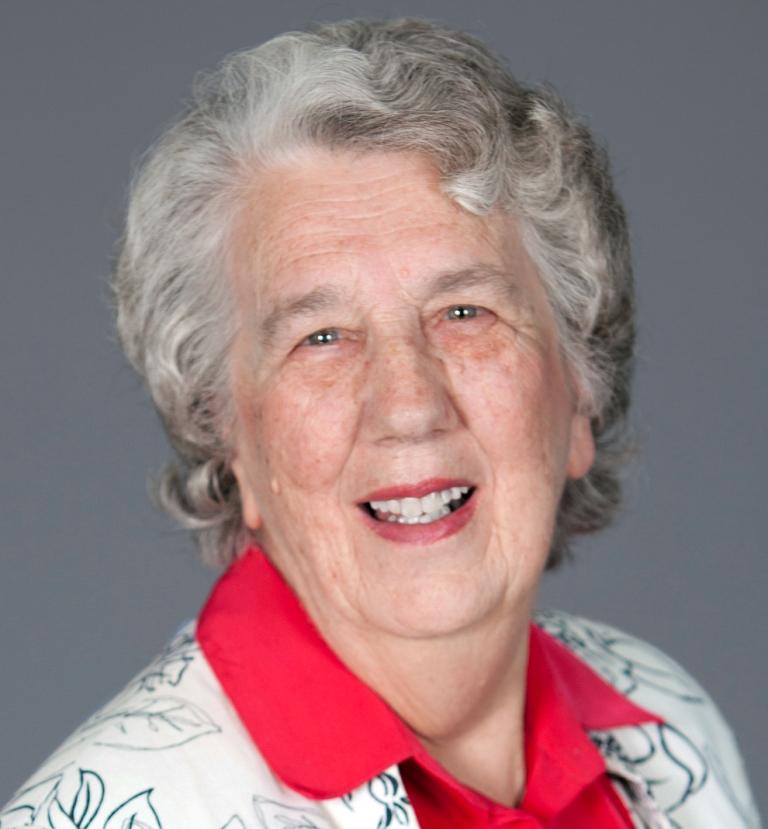
Nan Bolser OAM
One of the most giving, kind and caring people anyone ever met is a lady who many consider one of the Northern Beaches foremost citizens. Nan Bosler has been involved in volunteer community work for more than 66 years, committing countless hours holding positions ranging from member to National President and working with, and for, people of all age groups and levels of ability, with particular emphasis on the needs of older people and those with a disability.
Community awards including Anzac of the Year, an Advance Australia Award and the Medal of the Order of Australia (OAM) in 1991 ‘In recognition of service to the community, particularly youth, aged people and to people with disabilities’ are recognition of some of all she has done.
Nan feels strongly that learning is a lifelong experience and was over 50 when first attending University, gaining a DipEd Adult Community Ed, 1989; DipCommunityOrgs, 1990); BEd Adult Ed, 1993 and Master of Local Government, 1996 thereby.
Committed to enabling seniors to enjoy the digital age, and after retiring from paid employment as Community Development Officer Aged & Disability for Pittwater Council, Nan formed the Australian Seniors Computer Clubs Association (ASCCA) after retiring in 1996. Through the growth and development of the Australian Seniors Computer Clubs Association (ASCCA), Nan seeks to empower Seniors Computer Clubs to help older people use modern technology. ASCCA is the national peak body for Seniors and Technology and it is a Public Benevolent Institution. Nan is the foundation president of ASCCA.
A published author in many genres, her books topics range from local history to war history, include crafts, activities for disabled children, creative development of pre-schoolers, and community management. Her most recent book, The Story of Bob Waterer and his Family 1803-2010 was launched in 2011 by Her Excellency, Professor Marie Bashir AC CVO, Governor of New South Wales.
Nan is a member of ACCAN, National Cyber eSecurity Awareness Week committee, Digital Switchover Expert Group and has been an Ambassador for Seniors Week in 2013, 2014 and 2015. Nan has also been National Cyber Security Awareness Ambassador (2013) and recently appointed as president of the Frederick Meredith Descendants Group. Frederick Meredith is a First Fleeter.
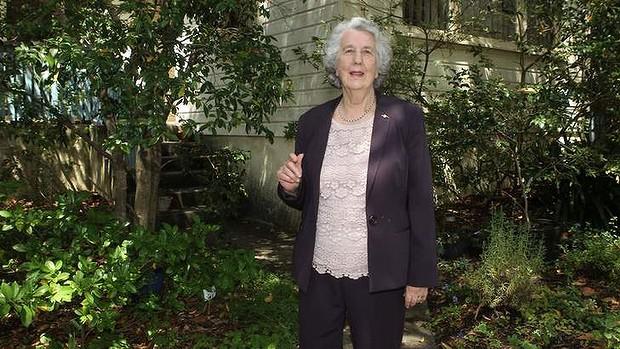
Seniors Week Ambassador
Nan was appointed to the inaugural NSW Carers Advisory Council in December 2010, was made a Broadband Champion, and in 2012 was a finalist for a Human Rights Award.
As with all great workings though, the story began way before now though:
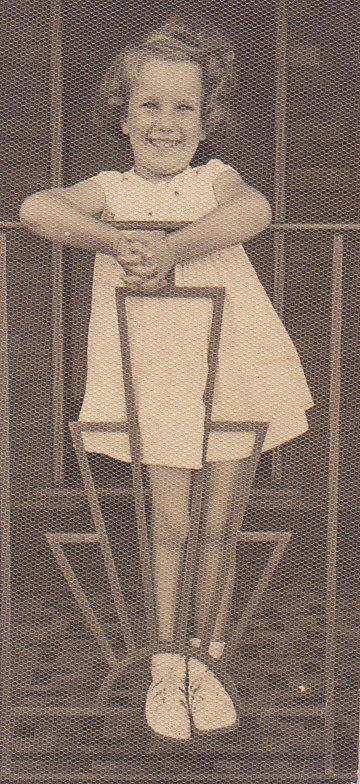 When and where were you born?
When and where were you born?
I was born in Strathfield on 24 January 1935. Yes, that makes me 80. My parents lived at Lane Cove at the time.
Where did you grow up and what were the most marked changes you saw in that physical environment of those places, and their social environment?
My father was an electrician with the NSW Railways so we lived in many places! The first homes I remember were in Epping. My memories are very limited but I do recall leaving my precious garden spade – a miniature of the one my Dad used – leaning up against the paling fence. I can still picture it through the eyes of my imagination.
My grandfather had given my mother a block of land at Seaforth, one of five he had purchased from the Seaforth subdivision sold by Henry F. Halloran & Co, Estate Agents. Once the house was finished we moved there. It became our family home and we kept coming back to it or to one of the other cottages that Grandpa had built each side of it. I was married from one of those houses in 1955.
Right: Nan 1938 -standing on the front porch of our new home in Seaforth
The second house in Epping was two doors from the Congregational Church where my new brother was baptised. The Church is no more; a block of flats sits now in its place. It was probably surplus to needs when the Uniting Church was formed. There were enclosed cosi fireplaces in the bedrooms and I remember being very worried about how Santa was going to get into my room at Christmas time. I also remember getting into big trouble.
We had a nice garden and I recall making posies of tiny flowers and putting a slit in a hydrangea leaf and using it as a backing for the posies. I would then stand out on the footpath and give them to people passing by on their way home from work. That was fine but my project was discovered when one of the people I had given a posy to came to the front door with some suiting samples ‘for the lovely little girl who gave me a posy to take home to my wife”. Well! no more posies after that.
Next we went to Yass. It was the war years and Dad was stationed at Yass Junction. My mother was very creative and happily by watching her I absorbed my love of anything creative. Birthday and Christmas gifts for family and friends were always hand made. She crafted beautiful little flowers from fresh bread and my dad would make backs for broaches, earrings and pendants by cutting shapes from tin cans, smoothing the edges and creating pins from safety pins with the heads cut off. Strangely, it was my dad who taught me to knit!
For Christmas 1944 Dad made me a book shelf from butter boxes, beautifully finished off and painted. I loved it and I still have it - well actually it is on loan to one of my grand-daughters. I can’t imagine how many different colours it has been painted over these last 70 years.
When the war ended Dad was moved to Dungog but there was no accommodation available for a family so Mum, my brother and I stayed with our grandparents at Parramatta while a transfer was organised for Dad to come closer to Sydney. There was a tenant in our house so it was required by law that the tenant be found ‘acceptable, suitable accommodation’ to move to before we could get him out. We moved back to our house on Christmas Eve 1945.
Christmas dinner was tinned campie (I don’t recall what else) and the table was an upturned packing case. So what, we were home, we were going to be a family again. The grass was very long and mum cut it with a pair of scissors. Dad was aghast when he found a neat row of bulbs with tiny white flowers planted with great care. Mum had carefully transplanted onion weed – she thought they were bulbs that had deteriorated because of lack of TLC. Needless to say I learned my love of gardening from my Dad not my Mum.
Enough to say that there were many many different homes during the next decade or so.
As a child and then teenager I had little thought for the physical or social environment but I did develop a great love for the bush that was in profusion at Seaforth. Moving so much meant that I have no lifelong friends from school days and each time we moved some of our favourite books and toys would go missing.
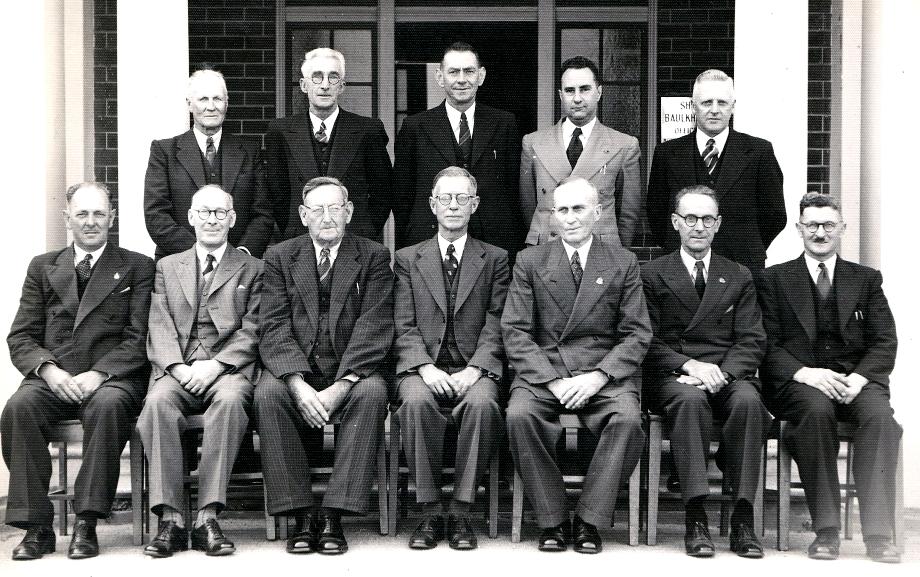
Above: During war years (WWII) Nan's grandfather Cr. William Charles Fisher was an alderman on Baulkam Hills Council. He is the gentleman in the back row at far left.
Above: William Charles Fisher had purchased the blocks at the corner of Princes Promenade and Edgecliffe Esplanade shown on Halloran’s subdivision map: this 1946 photo actually shows the front fences to the blocks in question but more particularly it shows our street when we moved back after the war.
Where did you go to school?
I began school at Balgowlah Public School (now known as Seaforth Public School) for part of kindergarten, then the family moved to the second house in Epping and I went to Epping Public School for a year or so before our next move to Yass.
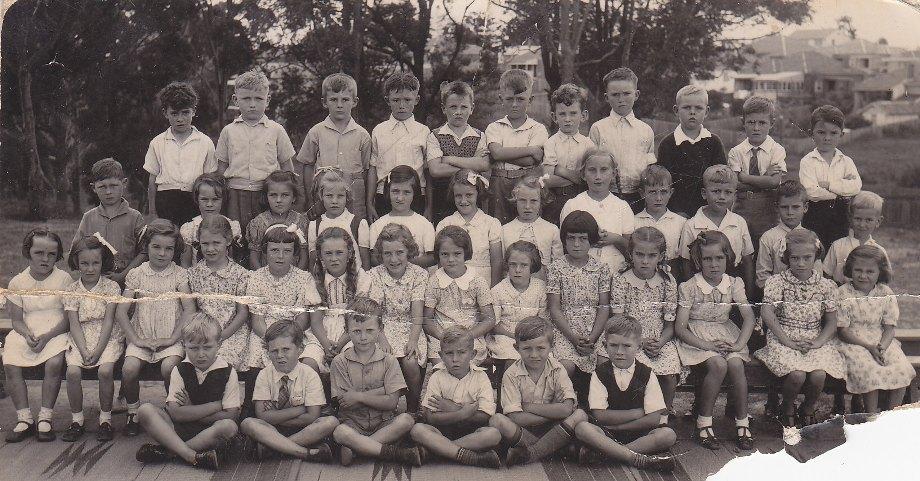
Above: 1941 - Epping Public school, Class 1A
As soon as we had moved in Mum, my brother being pushed in his stroller and I went down to the grocery shop to order food for our empty cupboards. On the way home Mum sighed and explained that she had forgotten to give her address. She would have to go down again after Dad got home to mind us and give the address so that we would have food for tea. She had no need to worry. The food was waiting on the doorstep when we got home. We soon discovered that everyone knew everyone in a country town and no one new escaped notice.
I began at the public school but it was a long walk from home and I had to cross the old wooden bridge across the Yass river. I was terrified that I would fall through the cracks between the planks across the bridge! (I was only five) I was allowed to attend the convent school which was closer to home and there was no bridge to cross!
A great air raid trench was dug at the end of the playground and when it was finished we were all lined up and marched to the trench for an air raid practice. A plane flew overhead to watch us. The pilot reported that the row of upturned pink faces stood out too much and that we would have to do it again but this time keep our heads down. I recall the dancing in the street when war ended and it wasn’t long before we were heading back to Sydney. I had passed the high school entrance exam while in Yass but it wasn’t accepted that a 10 year old child could go to high school in the city so I returned to Balgowlah Public School for 6th class. I found it hard to fit in. I was the scrawny little kid from the country who couldn’t even swim!
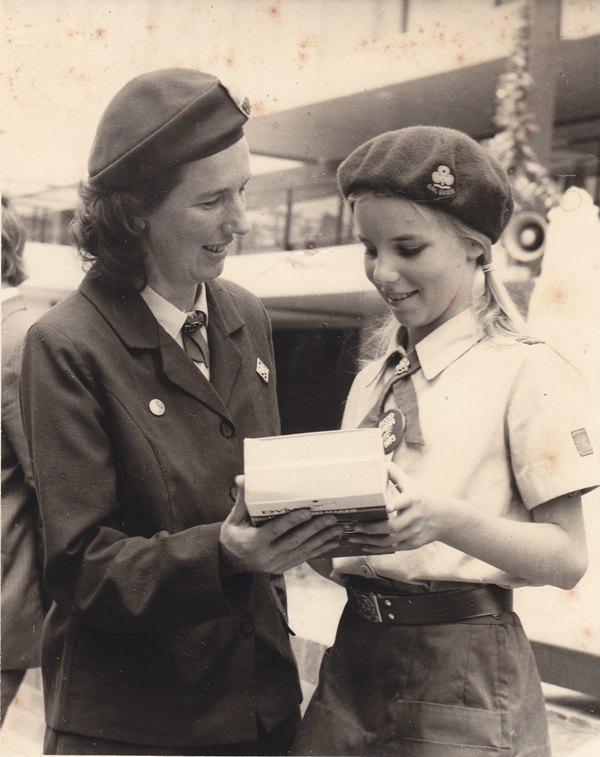 I walked past a little stone building on my way home from school each day and one day I hesitantly went in to see what was inside. It was magic; it was full of books; it was a library run by the Balgowlah Children’s Library and Craft Movement. I was able to escape into the world of books and slowly my world expanded and life was fun again.
I walked past a little stone building on my way home from school each day and one day I hesitantly went in to see what was inside. It was magic; it was full of books; it was a library run by the Balgowlah Children’s Library and Craft Movement. I was able to escape into the world of books and slowly my world expanded and life was fun again.
I didn’t know it but I had begun a relationship that has played a very important part in my life. As an adult I rejoined the Children’s Library and Craft Movement under its new name of The Creative Leisure Movement. In 1969 the organisation had changed its name to the Creative Leisure Movement (Children’s Library and Craft Movement). In 1943 the Balgowlah Children’s Library and Craft Movement Library had opened. It is now the Balgowlah Seaforth Library and it is still run by volunteers.
Towards the end of that year I discovered Girl Guides and that too was a major factor in my life. I was to be a member of that organisation for more than 50 years and that included being a Brownie Guider, the District Commissioner for 3 different districts, a Division Commissioner and Assistant Region Commissioner. I was a member of several headquarters committees and a Commissioner Trainer.
Right: 1974 with Christine - Girl Guides
In 1947 I began high school at North Sydney Girls High School. When I was 13 my little sister was born. It was met with disapproval when I left school after the Intermediate Certificate. There was an expectation that girls from the school would go on to university. I did eventually follow that pattern; I just took a 40 or so year-long gap year! In 2001 I was amazed and proud to be added to the School’s Hall of Fame.
What did you do after leaving school- what field did you go into?
After I left school my paid employment and volunteer work began to merge. I did a Day Secretarial Course at Sydney Tech. At the end of the course, in which I didn’t do very well in shorthand, I applied for and was offered 4 jobs and I chose to join the Commonwealth Bank. My first placement, 12 December 1950, was at head office in Martin Place, Sydney then a year later I got a move to the Commonwealth Bank, The Corso, Manly. It fascinated me to think that my maternal grandmother had been born in Bolton’s Cottage, on The Corso in 1882. She was the daughter of Jackson the bootmaker. I probably got my first taste of life other than with pen and paper when I was selected to participate in the first training program held by the Commonwealth Bank to introduce Burroughs Book Keeping machines into the bank.
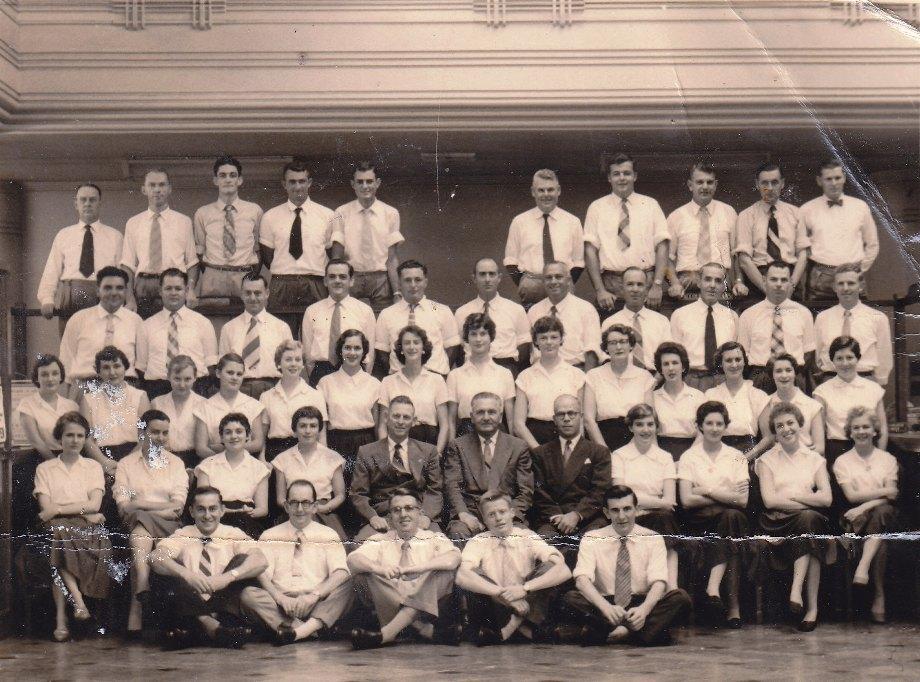
Above: 1953 Commonwealth Bank - Nan is 4th from the right in the middle row.
The Girl Guide Company I belonged to would meet at the Guide Hall in Ivanhoe Park, Manly each Saturday. My brother was a cub and his pack also met in the park on the same afternoon. I used to wait for his pack meeting to finish and we would then go home to Seaforth together. While waiting for him I noticed another group of boys in cub uniform racing around the park. Eventually I realised that they were without a leader but somehow their parents didn’t know that their cub experience was not as it should be. To shorten the story I began my life as a volunteer by taking on that group of boys. I did a Cub Instructors badge at Guides to help me.
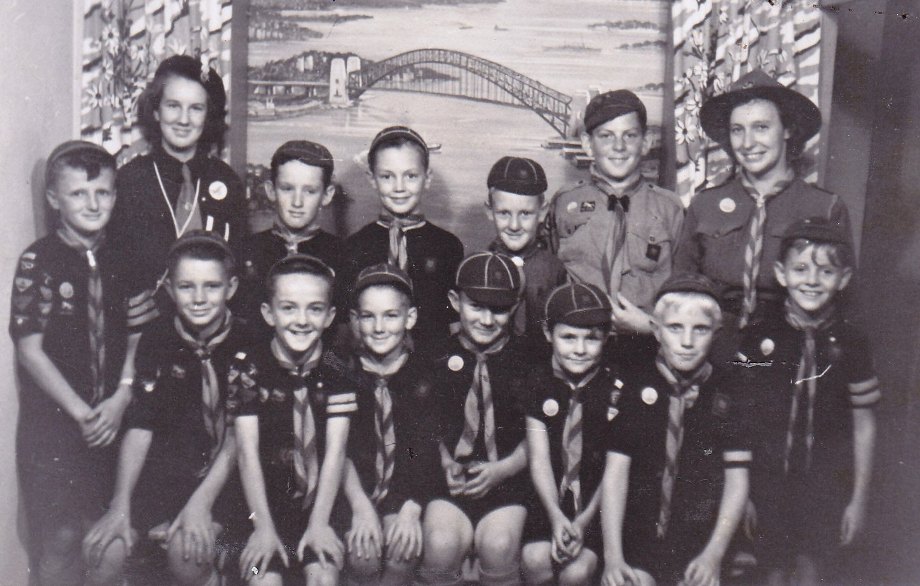
Above: 1949 Cub instructor - Nan is 14 here and at the back on left - brother Ron is 3rd from left - front row - sitting
When I turned 16 I advanced from guides to the Sea Ranger Crew, SRS Sirius. How I wish I had known then that I had an ancestor who actually sailed in the original Sirius of the first fleet! I’m sure my Skipper would have been very impressed. I continued with the cubs, 4th Manly (Salvation Army) to be exact, until eventually an adult leader was found for them.
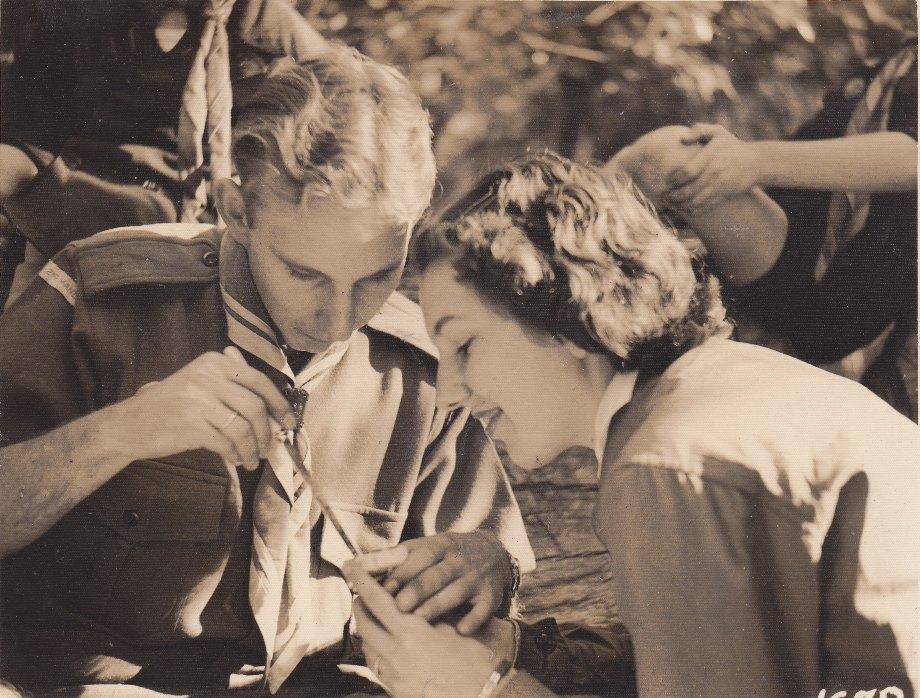
Above: 1952 with Bill
I then asked the Scout District Commissioner if there was another cub pack that I could help with. He told me that 2nd Manly needed an assistant. I went off to meet Akela, the cubmaster, his name was Bill Bosler. My cub name was Baloo, and Akela was very quick to make sure that I realised that “This is strictly business Baloo!” Absolutely was my response, however … three years later we married with a guard of honour of cubs and scouts!
Even though we had decided to get married I was about to make my debut and an engaged girl was not acceptable, so we had to wait until after the ball to announce our engagement.
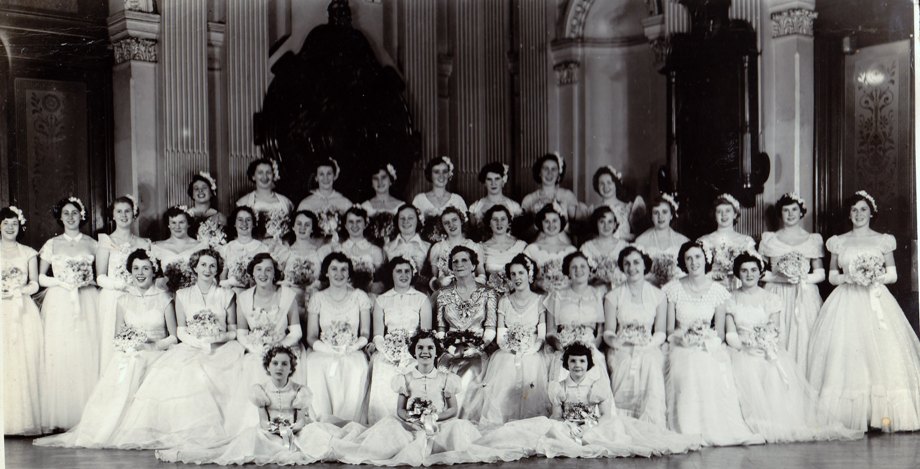
Above: 1952 Debutante Ball
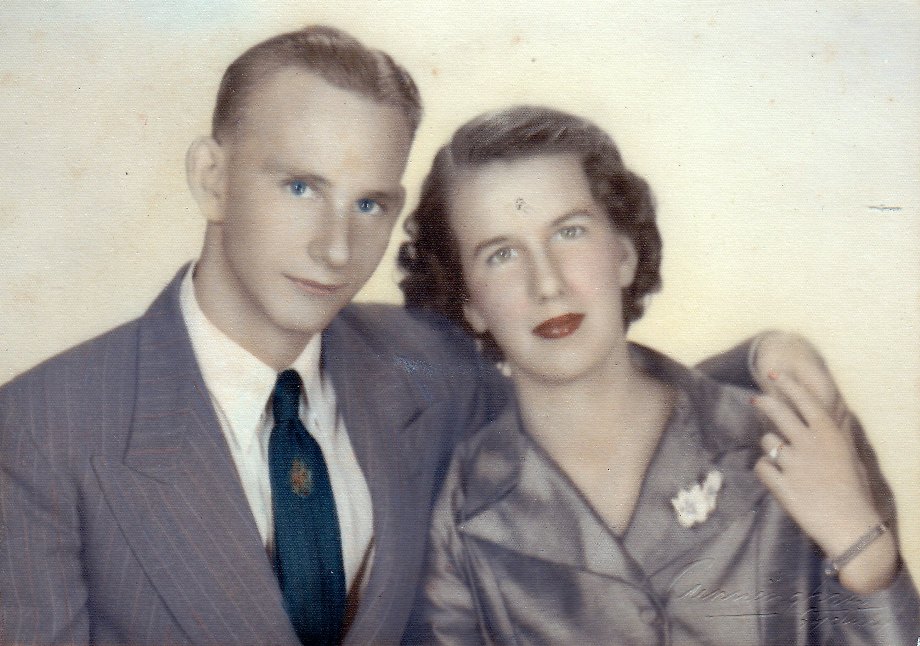
Above: 1952 engaged
One of the first things we did once we had decided to get married was to look for land to build our future home. Bill also took out some Building Society shares to help with the necessary finance for when the time came to begin building. We found it difficult to find the land we wanted and that we could afford. We even drew up a sketch for a large one room extension that could be built onto the back of the Bosler family home at Balgowlah but even that was beyond our immediate financial means.
The search for land continued and eventually it took us to Collaroy Plateau. The estate of the late Jessie Green was being advertised. It was a lot further out than we had planned but the views were good and the price wasn’t too bad. Maybe….perhaps. The one on Edgecliff Boulevard had wonderful views, but it was too pricey - £300 and the foundations would be just so expensive to build. The blocks in Claudare Street had only a 40 foot frontage but they were fairly long, 130 feet. The ones on the eastern side were £240, but the ones opposite were only £190. We fell in love with one on the eastern side, but the deposit was fairly high! Bill’s Dad came to our aid and lent us £75 and Lot 13, Section C1 was ours (well, sort of ours!) Many of our friends couldn’t understand why we had bought land ‘so far from everything’ they were sure that ‘nobody would ever live that far out.’
We were determined to pay off the land before we were married and saved everything we could - for instance going to balls which could cost up to £1.2.6 per person became a thing of the past - we had a goal. The magic thing was that we didn’t even notice that we were giving up things, we were so happy working together for our future.
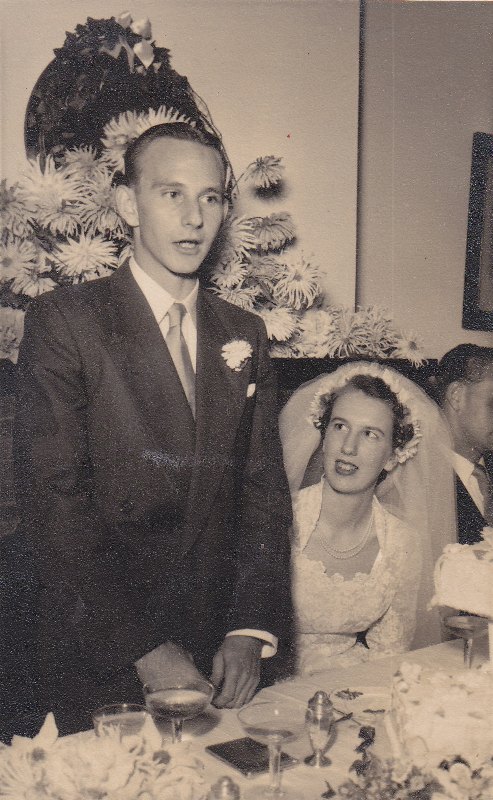 In the July of 1954 we set the date for our wedding. We would be married at St. Matthews Church, The Corso, Manly at 3.30 pm on Saturday 16 April 1955. The Corso was again becoming part of our story.
In the July of 1954 we set the date for our wedding. We would be married at St. Matthews Church, The Corso, Manly at 3.30 pm on Saturday 16 April 1955. The Corso was again becoming part of our story.
Right: 1955 The Bride and Groom
I was still working in the Commonwealth Bank. The Bank opened five days a week and a half day on Saturday so it was quite usual that any special shopping that had to be done in the City would be done on Bank Holiday, the first Monday in August. Bill was still at the Metro Theatre in Manly and luckily he was on night shift on Monday 4 August 1954 so it was on that day that we bought our wedding rings. Bill was sent home at lunchtime and that afternoon, with my Mum, I selected the material for my wedding frock and going away outfit. My mother made my wedding dress and my going away ensemble – even the underwear!
My future mother-in-law died four months before our marriage so for something old I had some of her silver hairs sewn into the hem of my wedding dress. We had also achieved our first goal, which included paying back the £75 loan - the land was now really ours.
The officiating minister, the Rev. A. Begbie, was delighted when my Dad and I arrived early! He would be able to hear the Head of the River race after all!
By October 1954 we had done a lot of work clearing the block. All the stumps that were within the house area had been removed. Each weekend we would travel by bus, carrying with us any necessary tools and a haversack containing picnic food, and work on the block. Bill would sometimes go up during the week when he was on night shift. The buses didn’t run very frequently. If there wasn’t a bus to the Plateau we would get one to Wetherel Street, South Narrabeen and climb up the goat track to the Plateau.
We often found square holes on the block and in surrounding blocks and this puzzled us for some time until it was revealed that Frank Hurley, world renowned photographer who then lived in Edgecliff Boulevard, would go around the plateau with his spade and remove native plants, particularly Christmas Bells, so that they wouldn’t be destroyed by eager builders.
Things were getting a bit hard. We had already drawn up plans for our proposed home and had them passed. Some six months before we had obtained a quote of approximately £2,100.00 to build the house but then we got 4 more quotes and the lowest was £3,096.00 and the highest was £3,460.00! This was quite beyond our loan at the Building Society so we decided on a ready-cut home. We selected a Hudson’s home and on the 2nd November we received the new plans and specifications having first paid a deposit of £50.00. We were still battling financially and realised that we would have to go into a flat for a few months until we could afford to build.
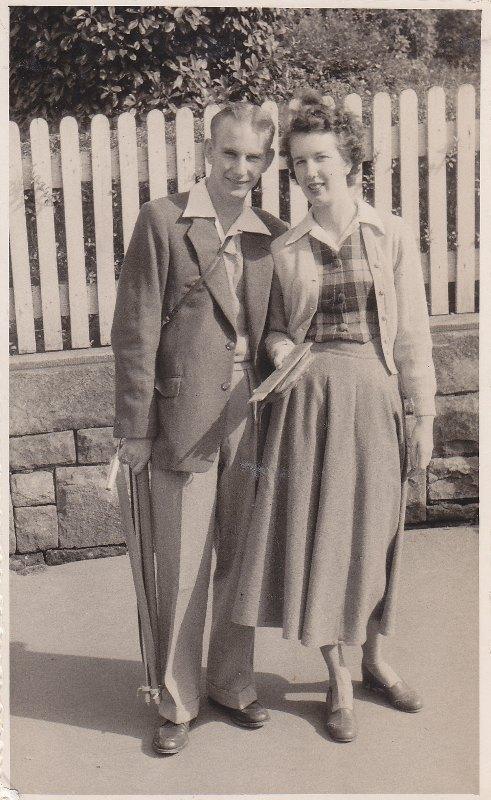
We began searching for a flat in the November of the previous year. By 1955 I was earning £4.2.2 a fortnight and Bill was earning about £8.0.0 but there seemed just nothing available under £5 a week. Housing was very hard to find and unscrupulous landlords were offering very poor accommodation at very high rentals. On 19 February 1955 we found a single room, and ‘share conveniences’ at 14 Sloane Crescent, Manly Vale. It was close to both the Manly and Wynyard buses. It was £2.12.6 a week plus half the gas and electricity costs. To secure it we had to pay rent from then until we returned from our honeymoon. It was hard on the budget but at least the honeymoon had been paid for in advance.
Right: 1955 Honeymoon at Katoomba
I had to resign from the bank to get married but applied to return. At that time no married women were employed in the bank, but on 16 May 1955 I was one of the first small group of married women accepted back into the employ of the bank. Mind you I had to return as a Temporary Female Assistant!
The flat at North Manly turned out even better than we had hoped. We liked our landlady and got on very well with her. Frequently when Bill was on night shift the bus Bill caught to Manly would pass the bus that I had caught on my way home from the bank. As the buses passed we would wave to each other.
We had done some more clearing and were ready to start building so went to the Building Society with the required deposit to organise the commencement of building only to be told that the deposit was now short fifty pounds. Despondent, we went away and saved the fifty pounds only to be knocked back again - cost had gone up yet again; still we were short of the necessary deposit.
We had had enough. We would build the house themselves, subcontracting the ‘hard bits’! We decided that we would live on Bill’s wages and have mine put straight into the joint account we had been using to save for the cost of building our house. We placed an advertisement in the Manly Daily and sold the shares for 250 pounds and made a profit of 100 pounds which was quickly added to our ‘building fund’!
By October the water had been laid onto the block and the toilet erected (yes, an old fashioned dunny.) The bricks for the foundation, the frame and tiles had been ordered. Building materials were still in short supply after the end of the war building boom and there were waiting lists for bricks and tiles. When your name came to the top of the list you had to take the bricks or tiles that were available, builders in the fifties didn’t have the luxury of selecting specific colours. If your preferred colour was delivered it was good luck not good management!
On Christmas Eve 1955 the foundations were laid for the House that Bill built.
By February 1956 Lot 13 Claudare Street, Collaroy Plateau was no longer just a block of land; a house was taking shape. The foundations, frame, tiled roof and guttering stood proudly for all to see. The fibro sheeting was slowly encasing the framework. Our dreams were taking shape at last. On 5th May 1956 we moved into the house, there was no wall cladding in the kitchen or bathroom, a camp stove stood on top of our new gas stove – the gas had yet to be connected, and washing had to be done by hand; we were still saving to purchase a washing machine, but it was ours!
I stayed at the bank until we had finished inside the house and then at the end of 1957 I resigned. In October 1958 the first of our three children was born and our house truly became a home.
I didn’t undertake paid employment until the last of our children was school age. We felt it was important that I was at home in those formative pre-school years. As with most young families the budget could always do with a boost and I chose to create craft which I sold in many shops on commission.
The Creative Leisure Movement, Narrabeen Community Learning Centre, when and why did this begin – and what did it seek to achieve?
The Children’s Library and Craft Movement was begun by two sisters, Mary Matheson and Elsie Rivett. Mary Matheson had been in England to complete her MA, with Honours, at Cambridge University and the idea of the Children’s Centre had been triggered by her visit to the David Copperfield Free Children’s Library which was located in what had been the home of Charles Dickens in London. Thirty pounds was spent of books for the first Library which was set up in the basement of the Quakers Meeting House in Devonshire Street, Surry Hills and it opened on 22 February 1924. Slowly the organisation spread across States. In 1969 it had changed its name to The Creative Leisure Movement (Children’s Library and Craft Movement).
The aim of Creative Leisure is to foster imagination, to give children, teenagers and adults the opportunity and encouragement to become absorbed in a creative activity of their own choice so that through this they can express their own thoughts.
To the youngsters it is all good fun but Creative Leisure has a serious basis being informal education through a very free approach and this in turn provides a therapy which releases tensions.
This philosophy has stood the test of more than 90 years and this concept is frequently announced as a new and remarkable advance in education.
I was very involved at St Andrews on Collaroy Plateau and was leader of the Young Wives Group in the early 70s (yes I really was young once upon a time) and we had a speaker from the Creative Leisure Movement.
At the dangerous hour called supper members of the group encouraged me to start an after school group for children on the Plateau. They knew I had been a Lady Cub-master and then a Brownie Guider and that I was crafty so why couldn’t I do it? I think they were the ones being crafty!
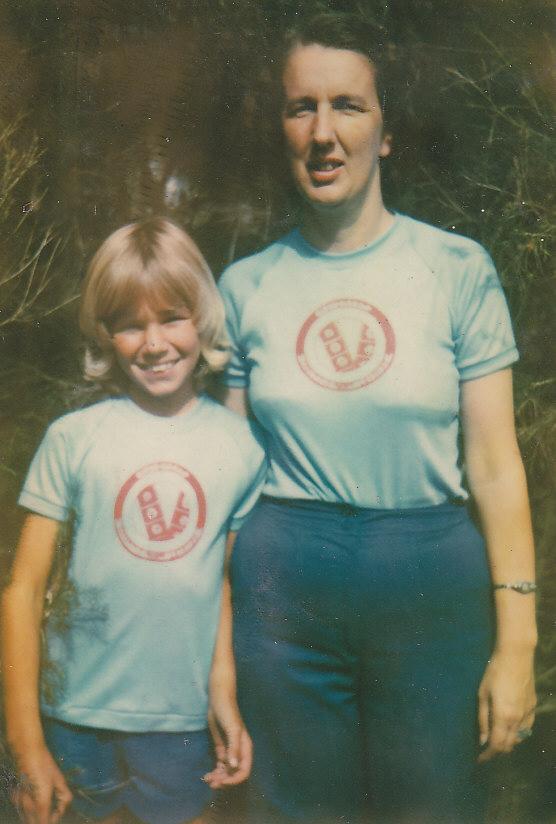 My last child had already started school so yes I would start an after school group. Of course it didn’t stop there. The after school group was providing a need and so I began to spread the idea until I was co-ordinating the organisation on the Northern Beaches and at its peak there were 2000 children and adults attending its various groups each week. I also became a director of the Creative Leisure Movement.
My last child had already started school so yes I would start an after school group. Of course it didn’t stop there. The after school group was providing a need and so I began to spread the idea until I was co-ordinating the organisation on the Northern Beaches and at its peak there were 2000 children and adults attending its various groups each week. I also became a director of the Creative Leisure Movement.
The groups ranged from Mums and their pre-schoolers in Under Fives Groups to activities for those in Nursing Homes. One teenage group was called Creative Artists. My husband Bill led that group and I was the gofa. Go for more film, go for …… I also did the organising.
Our work with teenagers and film caught the eye of Warringah Council’s Arts Officer who thought that if there was one teenage group making films there were probably others doing the same thing and so the National Youth Film Festival was born. Eventually I took over the running of the festival for some 14 years.
Right: 1977 - with Steve - Creative Artists
Creative Artists held weekend residential workshops. The first of any series was taking the film which had to be sent off to Melbourne for processing. The second one was held at least three weeks later and was editing and adding sound. There was also a third workshop and that was animation. The results were quite amazing and the special effects exciting and everything was done without the use of computers. Of course while these workshops were being run the question would have been what is a computer? Many of the teenagers who attended these workshops went on to successfully work in the industry or to use their skills to enhance different arenas of work. One 15 year old lad who attended the workshops was just a little different, he didn’t want to get behind or in front of a camera, he wanted to direct. We knew him as Mark but the world now knows him as 'Baz
Caring for evacuees after Cyclone Tracy 1974 and for refugee orphans brought from Saigon after the Vietnam War 1975 – how did you become part of this and what did it involve?
Christmas Day 1974 is etched in the minds of many because of Cyclone Tracy, an enormous disaster that befell Darwin! Great numbers were evacuated south and one of the evacuation centres was set up in the School of Artillery buildings at North Head. It was time for the Northern Beaches of the Creative Leisure Movement to step up and offer help. Volunteers gave up their holidays to provide activities for the children. The children were anxious every time there was any rain and they were reluctant to stay any longer than necessary in bathrooms because so many of them recalled the worst experience that they could remember when they had sought safety and shelter in the bathrooms of their now demolished homes in Darwin.
Hard on the heels of the Darwin Disaster came the evacuation in April 1975 of Vietnamese war orphans from Saigon. Many were to be housed at the Quarantine Station at North Head. Colleague and friend Jill Munro and I divided the list of government departments in half and we took to our phones to find the Department responsible and offer the assistance of the Northern Beaches region of Creative Leisure. Success! We found the right department and they knew of our work with the victims of Cyclone Tracy and we were in. Twelve volunteers a day gave their time to help these children.
We arrived each day at breakfast time and stayed until the last child was tucked into bed. As well as conducting activities we helped to dress and feed the children, to escort them to Manly Hospital for health checks and in short to become part of their day. Several of the children had been victims of polio but physical handicaps had been accepted and overcome, apparently without question. It was love at first sight for one seven year old boy when he saw his first dinky. He tucked his withered legs up, steered with one hand and propelled the bike with the other hand. Pure delight shone from his face. A teenager cheerfully carried a boy his own age on his back, No, a wheel chair wasn’t needed. (of course one was borrowed.) It was moving to hear a blind youngster giggling with glee as the clay squelched between his fingers.
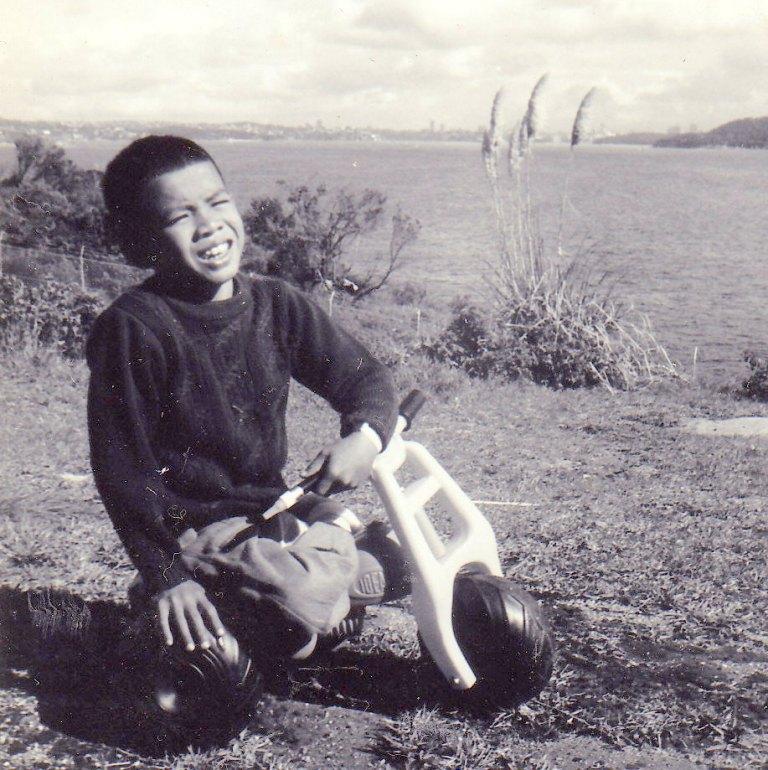
By the fourth day their need included activities, and the Creative Leisure Movement was anxious to be found equal to the task. Our thoughts were mixed as we unpacked our boxes of materials. Will we be able to cope? Will they accept us? We can’t speak their language. Breakfast over and the children spilled out of the buildings curious to see what we were doing. Why had we worried? Within five minutes we were completely surrounded by children eager to paint and try all we had to share with them. We forgot we couldn’t speak their language; the outstretched arms of a child say ‘hug me, love me’ in any language.
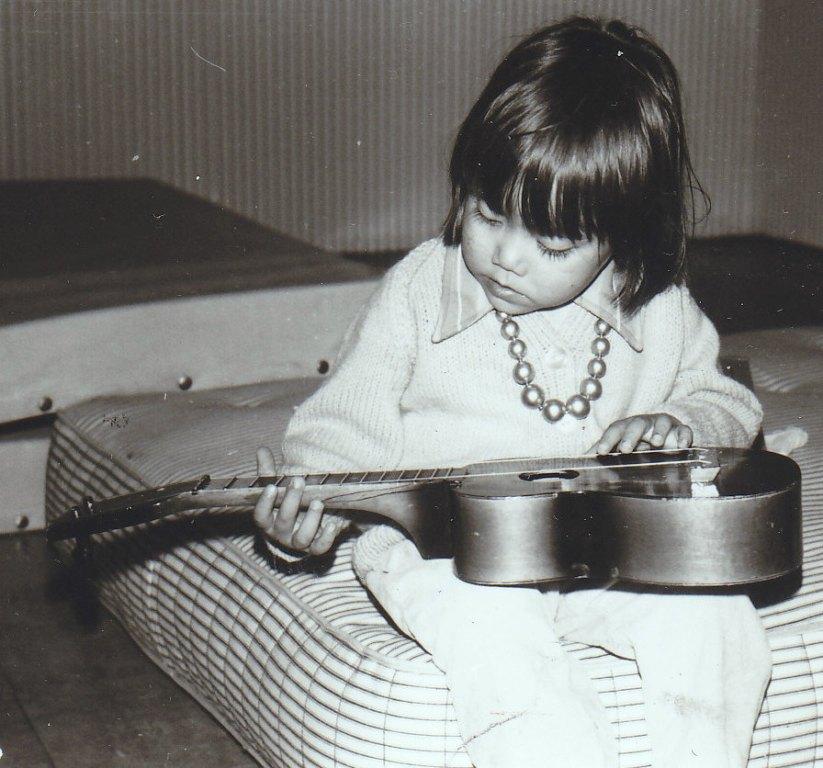
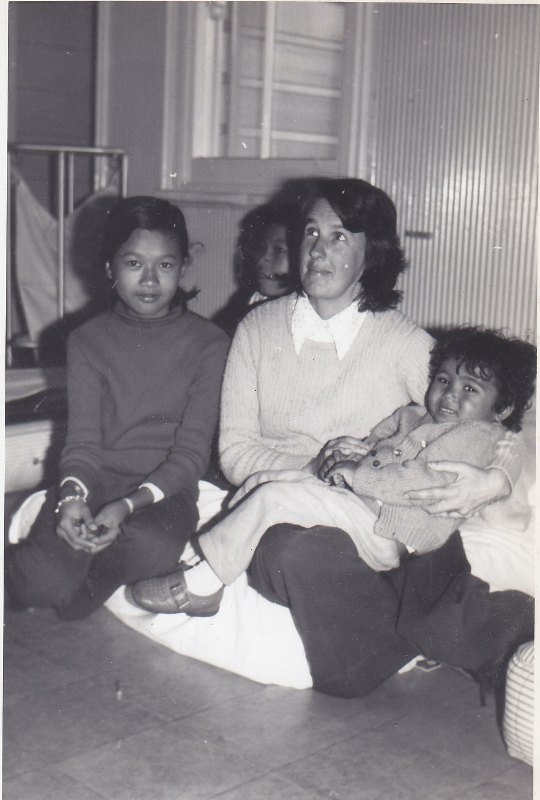 These children had much to teach us. They were so unselfish. Each would help the other and there were no problems about sharing equipment. They loved the clay work and would sit painstakingly creating something special and then show it to all to admire. But, then they would break it up and put it back into the bag of clay for someone to use again. Painting was probably their most popular activity but not one painting was kept by the young artists. It just did not occur to them to keep anything like that for themselves. The children we were working with were aged 2 – 17 years. It was sad to see that even at the tender age of two or three these children recognised the need to hoard food and clothes but not playthings. One delightful, vivacious young lady of 27 months had been picked up three times for begging in the street before she had been taken into an orphanage.
These children had much to teach us. They were so unselfish. Each would help the other and there were no problems about sharing equipment. They loved the clay work and would sit painstakingly creating something special and then show it to all to admire. But, then they would break it up and put it back into the bag of clay for someone to use again. Painting was probably their most popular activity but not one painting was kept by the young artists. It just did not occur to them to keep anything like that for themselves. The children we were working with were aged 2 – 17 years. It was sad to see that even at the tender age of two or three these children recognised the need to hoard food and clothes but not playthings. One delightful, vivacious young lady of 27 months had been picked up three times for begging in the street before she had been taken into an orphanage.
Right: Nan in 1975 with Vietnamese War Orphans
Most of the children were outgoing and eager for attention; the less lucky ones were very quiet and withdrawn. Only one was really aggressive – but what would you expect when at the age of six he had been the leader of a street gang of some fourteen boys? He could only remember, literally, fighting for his life. Most of the children had been under fire.
The Creative Leisure girls gave all they possibly could to these children, their love, their time and their talents but they felt the richer and knew that it had been a privilege to play a small part in helping these children to adjust to their new start in life. I must admit that I was close to tears when a lad of 10 years held up the bus taking the last group of children from North Head, just to find me and say goodbye.
I wrote the story of the Vietnamese War Orphans for Mia Mia, the magazine of the Mothers Union and received a 1975 Religious Press Award.
It had become obvious to me that there was much that could be done to add new dimensions to the lives of disadvantaged and/or handicapped children, their siblings and families and so I began to weave this need into the fabric of my community work.
Where possible disabled children were integrated into existing Creative Leisure centres. Those children were placed in a centre where they could achieve at their own level, where they were challenged to develop their potential a little more but not swamped by a program beyond their grasp. I remember a holiday program that was visited one day by 16 youngsters in wheelchairs. The children enrolled at the centre warmly welcomed their special guests (open and interested discussion the day before had wisely paved the way) and joint activities ‘worked’ all day. I can still see two youngsters working on the same picture. Sarah holding her brush at a strange angle, making paper and paint meet with great difficulty, Damon carefully adding a detailed background. Each understood their common aim and worked at their own level to create their painting. A diabetic teenager applied for a place in a residential Young Film-makers Workshop. Careful menu planning easily overcame that problem and yet another door was opened wide.
School holidays can be a traumatic experience for a disabled child, his siblings and parents. The first Drama/Craft workshop for intellectually disadvantaged children was held in January 1978 and Fisher Road Special School was the venue. A separate program for siblings was conducted separately but near-by. The siblings at first couldn’t grasp that they didn’t have to keep a protective eye on their brother or sister. Progress of the children and feedback from the parents was very encouraging and all were anxious that the workshops become a regular part of our school holiday program. (Which they did!) Parents spoke of children eager at first light to be up and ready for the coming day’s program. Mostly they spoke of the value of the break from the continual care of their child. The two most common greetings from Mums in the afternoon were: “it was a beaut day, I did nothing!” or “I had a wonderful day, I got so much done!” The Manly Daily referred to it as A Touch of Magic for the handicapped. During January 1982 I began running training courses with the aim of better equipping staff from holiday centres to enable them to cope with the requirements of disabled children and to help them have a greater understanding of their needs.
In 1981 changes to funding policy meant that playgroups run by the Subnormal Children’s Welfare Association needed to have separate committees running each group and managing any funding received rather than one overall organisation. Creative Leisure was asked if it would take over a small group in Dee Why because they would lose funding as they didn’t have a committee. I agreed and made a submission for funding for The Kookaburra Group, a “Specialised play therapy group for pre-schoolers with developmental delay for any reason, plus support for their mothers, plus liaison with other services working with those children, plus integration into community services.” The submission was successful and Creative Leisure received $1,729 for the first six months.
In 1979, the International Year of the Child, the NSW Children’s Services Study had shown that Warringah was one of four localities given special mention as having inadequate children’s services in relation to the population of children. It was also interesting to note that few committees had received support from their local councils such as the Warringah Committee had received from Warringah Shire Council. I was secretary and Pat Frater was treasurer of the Warringah Co-ordinating Committee for IYC.
One of the last submissions made by the Warringah IYC committee was for funding to establish a toy library for children with handicaps. A further submission was made to the Handicapped Persons Bureau for Toys for such a library. When the committee wound up at the end of the year they had no knowledge of the outcome of the submissions. Pat and I undertook to give ongoing support if the submissions were successful.
We did receive one of the ‘kits’ of toys – several large cardboard boxes containing 250 toys, 50 large plastic bags, 30 books and a stack of blank catalogue cards. No funding was received to start the library. The cardboard boxes were the library! We formed a management committee and I became the president and Pat the Co-ordinator of the Warringah Toy Library for Children with Handicaps. We opened the door of the library on 18 March 1980 in one room of a council property at 14 The Kingsway, Dee Why. The name was changed to Cubby House Toy Library For Children With Handicaps and Special Needs on 11 March 1985.
The toy library was a member of the Australian Association of Toy Libraries for the Handicapped and towards the end of the 80s I became national president and the secretariat became yet another of the Learning Centre’s tenants. I was president of Cubby House for 13 years and then had the honour of being the patron. I also wrote the history of cubby house’s first 21 years.
During 1979 the Narrabeen Community Learning Centre was established in buildings previously occupied by the Narrabeen Girls High School. The Education Department land facing Pittwater Road, North Narrabeen had been home to both the girls and the boys’ high schools. It was the Department’s plan to demolish the two schools and build a modern co-educational high school in the middle of the site. The boys’ school was demolished first but luckily for the community only half of the girls’ school had been raised when the P & C Committee of the Narrabeen High School sought the help of Warringah Shire Council to persuade the Education Department to rethink the situation.
Warringah Shire Council and the Education Department discussed plans to turn the remaining buildings into a community facility. The Council carried out alterations to make the buildings suitable for community use. A new toilet block was built for the users of the ‘old Gym’ which was to become the venue for community theatre groups. Prior to the opening of the Centre community groups had been invited to apply for use of rooms in the new facility. Up until that time Creative Leisure for the Northern Beaches was run from my home. We even had an after school group at home and to this day I occasionally dig up a piece of copper enameling, a mosaic tile or piece of pottery in my garden. Those attending loved the creek that Bill put in across the yard. It was perfect for sailing little boats or at times for trying to catch tadpoles. But, when Bill asked our son what he thought the linen press in our hallway should be used for and he began his response with “wool, cane, felt, craft materials” … I knew that it was time to have an office and storeroom away from home. I applied for use of part of the centre for the Creative Leisure Movement and it became one of the first six tenants.
The Hon. Eric Bedford, Minister for Education officially opened the Centre on 4 October 1979. Eric Bedford was later to become a colleague and friend when we were both members of the NSW Committee on Ageing.
It was decided the Centre should have a part time co-ordinator and I was persuaded to apply. Even though I was made to feel very conscious of my lack of education I was appointed to this position on 12 December 1979. To begin the Education Department was my employee and then the role of employer was taken over by Warringah Shire Council. The story of the Narrabeen Community Learning Centre would take a chapter of its own; sufficient to say that it became the hub of the community.
You went to UTS as a mature aged student and excelled – what was the impetus for this to begin with?
While at the learning centre I began to undertake tertiary studies. Each qualification I undertook allowed me to improve my work at the centre. The first one I did was the Associate Diploma in Adult Education. A brochure had arrive in the mail and I saw it as a possible way to improve my education and so be better equipped to provide the adult education programs that I was developing at the Learning Centre. Then I noticed that the date to apply for enrolment had already passed. Being determined I sent off an application anyway adding in my covering letter that I didn’t think that a missed date should stand in the way of an enthusiastic co-ordinator! I was accepted.
I had taken part in focus groups discussing the need for a qualification for Community Co-ordinators and when Kuringai CAE (later UTS) decided to run such a course I offered the Learning Centre as a venue. I understand that the Learning Centre became the first off campus location for the Associate Diploma in Community Organisation. When an administration fee was introduced part way through the course about half of the students had to drop out because they or their organisations were unable or unwilling to pay the fee. With that reduction in numbers the course was transferred back to Lindfield.
I had developed and run a ten week course on Creative Activities for Diversional Therapists working with the elderly. It was very successful and Brookvale TAFE heard about it and asked if I would run it again at the College. This led to an invitation to work with other TAFE lecturers to develop a Certificate in Working with Older People and an Advanced Certificate in Working with Older People. I wrote several of the curricula for the courses and taught many units at either Brookvale or Seaforth TAFE. My TAFE teaching was in the evenings so as not to interfere with my Council job. I was elected to the Brookvale College Committee and continued with that Committee for 9 years, ending up as Deputy Chair.
After graduating from the Assoc. Dip.in Adult Education I undertook the Bachelor of Education. Next I was appointed the first advisor at UTS working with students who were working with older people. I later became a part time lecturer in the faculty of Adult Education.
John Jeffries was Warringah’s Arts Officer in the 80s and he asked me if I would do something to mark Heritage Week. Of course my response was yes. Then I began thinking; through the Wage Pause Program I had an assistant at the learning centre and, as was to become my normal practice whenever I had such a person working with me, I had asked her what sort of job she hoped to get once she had finished her year at the Learning Centre. I had been a bit taken aback when she said she wanted to be the director of an Art Gallery because I was finding it hard to think of what sort of tasks I could give her to equip her for such a position. “Something for Heritage Week” was my answer. We could organise an exhibition and use her as the front for all promotion and publicity because surely organising an exhibition would fit well when seeking a job in an art gallery and media articles would look really good with her C.V.. We sought people to share old photographs with us (which I re-photographed and then returned the precious originals to their owners.) and allow us to interview them. The exhibition was a great success and one week after Jo left me in June of that year she began work as the director of the Muswellbrook art gallery.
People’s interest had been roused and I continued to get calls from people who wanted to share their memories and photographs with me. As a result later that year I formed the Local History Resource Centre and the centre then had its own historical society complete with members and volunteers. It wasn’t long before I sought to do the Graduate Diploma in Local and Applied History at the University of New England (by distance education) and began a program of publishing local history books.
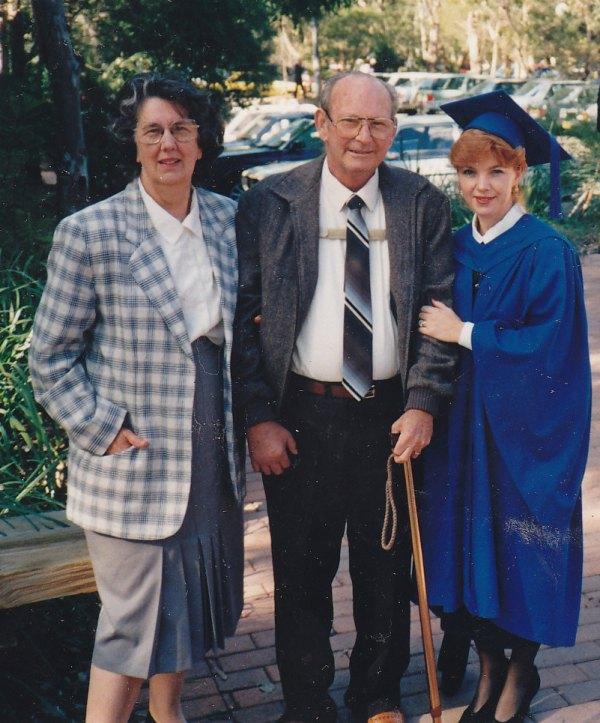
Above: 1994 Sue's Graduation
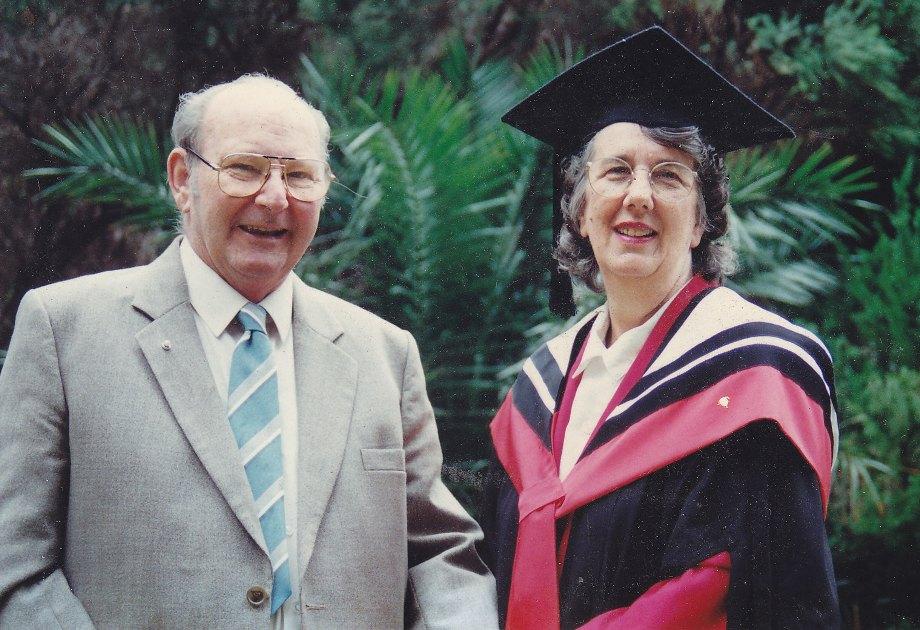
Above: 1996 Nan's Masters
What part did The Creative Leisure Movement, Narrabeen Community Learning Centre, have in establishing what is now known as the NBI and what other activities did it do?
Thirty years ago here weren’t any support services for families with a disabled child and respite was a virtually unheard of term. Mercy Family Life became the umbrella for the first Interchange Program. When Manly Warringah Interchange established the Host Program in 1983 it was the second community respite service for children with disabilities in NSW.
The Host Program linked families in the community to a family with a child with a disability for regular respite. It was an innovative program based on a similar model operating in the UK. A pilot program had already been established by Action for Handicapped Citizens and Mercy Family Life Centre at Waitara and this service initially supported a small program on the Northern Beaches.
However it soon became apparent that the Mercy Family Life Centre at Waitara couldn’t meet the needs of families in Manly Warringah and a local based organisation was needed to administer the program. Creative Leisure was approached and I provided accommodation at the Learning Centre and became president of a newly formed Management Committee. Interchange have over the years encompassed many much needed aspects of respite and been a great leader in this field.
Interchange started off in one room at the Learning Centre, it was located next to my office and a little mouse had made a small hole in the wall between my office and the Interchange office and through it a connecting lead from their computer to my printer solved an early equipment problem!
Soon it was necessary to remove a wall on the southern side of their room and include a second room but eventually that too was too small and they moved to the Nelson Heather Senior Citizens Centre, now the Nelson Heather Centre.
I encouraged Interchange to incorporate as a separate entity to the Creative Leisure Movement as it was becoming awkward when seeking funding. It was a little sad to see ‘activity of the Creative Leisure Movement’ disappear.
When it became apparent that the Creative Leisure Movement was about to wind up I set about encouraging the Northern Beaches activities to become an incorporated organisation in their own right. This new continuation of the Creative Leisure Movement is the Northern Beaches Creative Leisure and Learning Inc. and it still operates. Leisure and Learning in the title made me smile as that was the name I had given to supplements I wrote each term in the Manly Daily for nearly 20 years.
The holiday programs at Fisher Road took new form under Interchange and the last of ‘the family’ to come under the umbrella was the Kookaburra Play Therapy Group. Many families along the Northern Beaches owe a great deal to this special organisation now known as NBI.
Through Creative Leisure I planned the first International Folk Dance Camps to mark the International Year of Youth in 1985. I looked after the organising, sought the funding etc. etc. while Carol Maddox was the artistic Director and organised the tutors. My first task was to convince the Narrabeen Lakes Sport and Recreation Centre that a Dance Camp was appropriate as a user of the centre! We continued to run these dance camps for more than a decade and during that time we brought to Australia the cream of international folk dance tutors. The camps catered for students from 10 – 18, and adult teachers from both Dance Schools and primary and high schools. They were residential and ran for a week. We even held a workshop to teach dance to disabled adults, many in wheelchairs. We also welcomed on one occasion a folk dance group for seniors who came to give a demonstration. One older lady confessed to me that she just loved folk dance and when I asked her why she shyly said that she was ‘skin hungry’, she had been a widow for a long time and it was only through dance that she was able enjoy human contact.
When Pittwater Council became a reality the Learning Centre was located in the new Pittwater Local Government Area and my employment was transferred to Pittwater. I was invited to move to the position of Community Development Officer – Ageing and Disability. Instead of managing one community centre part of my job was to manage all of the Community Centres in Pittwater. My place at the Learning Centre was taken by Virginia McLeod who was to become a skilled historian and who continued the work of the Local History Resource Unit.
Eventually the High School required the Learning Centre’s buildings for school purposes and this valuable community hub was closed. The resources built up in the Local History Resource Unit became the basis for the Local Studies collection at the Mona Vale Library. Happily Virginia also went with the collection to the Library.
I had begun my Master of Education in 1993 but after one semester I realised that the topics I was to study would do little to improve the work I was doing at Council and when I realised that there was a Master in Local Government Management I transferred to that course. In 1984, after just one more semester, Bill had his two strokes and I took leave from the course. I had become his primary carer. I did go back and finish my Masters and graduated in 1996. I had intended to go on and do my PhD but Bill asked me not to do any more study, so it got put on hold.
I continued to work until 1996 when his needs were becoming greater and I was needed at home full time.
Since teenage years I have been actively involved in so many organisations and events that I find it hard to remember them all. Bill had always supported me and our children and encouraged me in my volunteer work which enabled me to indulge in my love of community. In 1977 we had both become Justices of the Peace so that we could help others who needed the services of a JP locally.
Even the 13 years while I was my husband’s primary carer I still kept involved, but mostly via the internet and with less frequent meetings. I would arrange respite so that someone would be with Bill if I was out of the house for more than two hours. I accepted invitations to speak at conferences for the first 11 years and I took Bill all over Australia. Careful homework made it possible and I would usually add a couple of days after the conference to take in tourist sights – that were accessible – and that is another story. Bill loved the change in environment and as is often the case with conferences with similar themes there were usually a core of people he had met attending so it helped him to feel still part of the world outside our home. These trips were not possible for the last two years.
After Bill died I became even more involved in community work and accepted the invitation to be on several more committees and boards. It made it easier for me when I was fully occupied. When the Ministerial Carers Advisory Council was formed I was a member of the inaugural council. My term was completed in December 2014. I have also had the great pleasure of being a NSW Seniors Week Ambassador in 2013, 2014 and 2015. I was Cyber Security Awareness Ambassador in 2013.
I work longer hours than when I was in paid employment. My retirement is fulfilling and rich.
As Community Development Officer - Aged & Disability for Pittwater Council, what did this involve and what did you do?
As an emerging Council many staff members took on multiple areas. My position entailed many tasks but here are a few of them. I managed the community centres and supported any staff located in them. There were ten centres at that time and the centres were provided by Pittwater Council as an integral part of their support to community organisations.
The Centres were for use by individuals and community groups to pursue their various social, sporting, cultural, artistic and religious activities. The coastal Environment Centre was very exciting, set on the edge of Narrabeen Lagoon. It had a specialist library and provided information on a wide range of environmental issues and interest. It also held exhibitions and community events.
I attended all of the Management Committee meetings. It was exciting and satisfying to be able to support the enthusiasm and ideas that each centre developed. Occasionally it was also frustrating. Visiting the centres gave me a far greater understanding of their needs. I loved visiting Scotland Island but have to admit it wasn’t always easy in bad weather getting from the ferry, sometimes onto another small boat and then onto the jetty. I always hoped that onlookers couldn’t see how nervous I was negotiating my way onto dry land!
In 1996 I prepared a Community Centre Information Kit outlining details about all of the centres.
The position was part HACC funded and included in my list of tasks was supporting the Access Committee. I was most grateful that I had some knowledge of those with disabilities from all the work I had done previously with groups and activities for disabled children. Towards the end of my time with council I also had the experience of being a carer for a severely disabled adult.
The Committee organised Access Walks in several shopping centres. The one at the Newport shopping centre was in 1996. Participants were chosen on the basis that they could influence the planning, design and development of the shopping centres in Pittwater. Each participant was allocated a guide to ensure their safety and to raise awareness of how access problems affect so many people in the community. The guides who volunteered their time were professionals and Access Committee members experienced in working with people with disabilities and older people.
It didn’t take long for the participants to realise just how difficult it was to negotiate the shopping centre while in a wheelchair, on crutches or when blindfolded. I do recall that when we did a similar walk in Mona Vale we almost lost our local MP when in a wheel chair and trying to negotiate a steep section of footpath almost proved just too difficult! The outcome of these walks was a greater understanding of the difficulties that lack of appropriate planning can create.
Seniors Week was always a time of great celebration in Pittwater. We decided in 1993 that the theme would be Positive Images. A creative writing competition, To promote, among people of all ages, a more positive understanding of ageing was run for all age groups and winning entries were published in booklet form. Nominations were sought from the general community for Leaders within Pittwater and their work acknowledged. As a highlight for Seniors Week on St Patrick’s Day a garden party was held for residents of nursing homes and it was also attended by little leprechauns! The children from Council’s Warriewood Children’s Centre sang for the assembled seniors and then judged the best St Pat’s hat. Story tellers and bands from Pittwater and Barrenjoey High Schools also entertained the garden party guests.
Two events that I enjoyed organising were the Aboriginal XI v’s a Mayoral XI for Australia Day 1994 and the Festival of Bunna Bunna at the Coastal Environment Centre. I was also a member of the Disaster Welfare Team and was involved in the awful bush fires at the beginning of 1994.
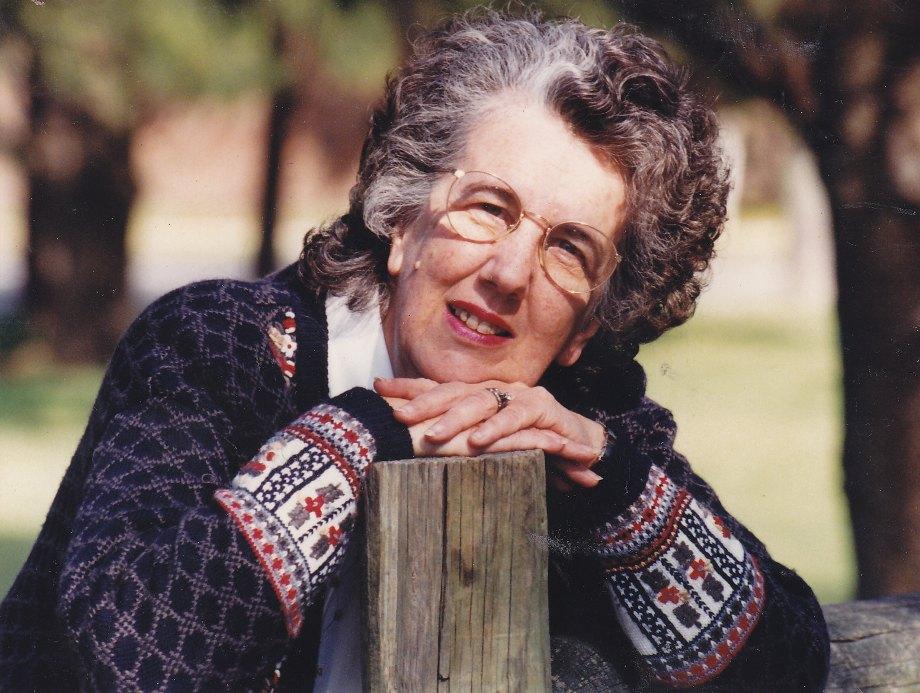
Above: 1996 Retirement! August
Your OAM, announced on Australia Day 1992, cites “In recognition of service to the community, particularly youth, aged people and to people with disabilities” – how did it feel to receive this and what other awards have you received?
I was amazed when the letter arrived telling me that I was to receive an OAM. It was a total surprise and I couldn’t imagine receiving such an award for doing what I loved to do. I had no idea who would have nominated me. It was for 40 years community service in my local community and I was determined that I would continue to earn that recognition for as long as I was able and to expand the work I do to include national and international work which I am happy to have achieved. It was the same for the Centenary Medal, actually I hadn’t even know that such an award existed! The citation for that medal was “For service to the seniors community, including helping seniors to use information technology.”
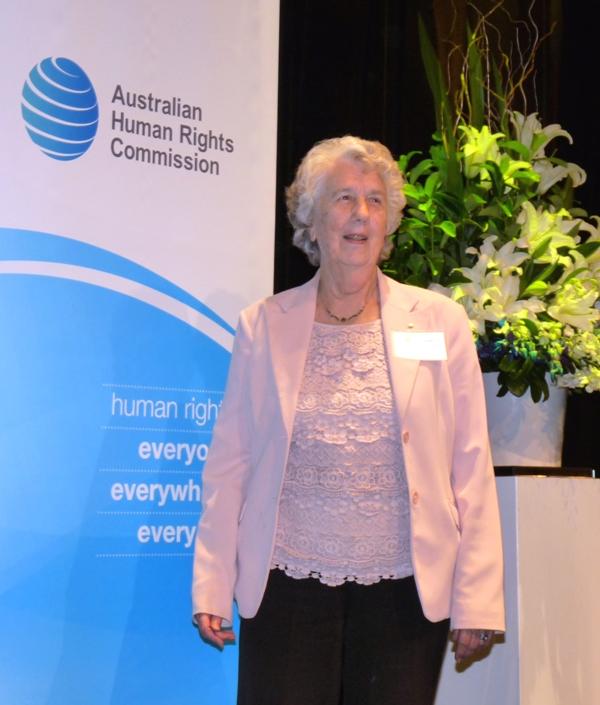 The other award that greatly humbled me was the Anzac of the Year Award in 1984. In its desire to honour those who serve in peace as well as perpetuating the memory and gallantry of those who served in war, the Returned & Service League of Australia has established a series of National Honours – the Anzac Awards.
The other award that greatly humbled me was the Anzac of the Year Award in 1984. In its desire to honour those who serve in peace as well as perpetuating the memory and gallantry of those who served in war, the Returned & Service League of Australia has established a series of National Honours – the Anzac Awards.
The Anzac Awards include the Anzac of the Year Awards, seven of which may be awarded each year to Australian individuals or groups for service to the community in a positive compassionate and selfless manner.
Right: 2912 Humans Rights Finalist
A medal struck for the Centenary of Warringah Council in 2006 also sits proudly in my china cabinet. I had been chosen to be the Chair of the Warringah Centenary Committee.
Other awards I have received include:
Religious Press Award, 1975Outstanding Citizen Award, Warringah Shire Council 1975
Frank McAskill Trophy for the improvement of life for older people 1983
Philip Geeves Memorial History Award, 1986
Advance Australia Award 1987
Certificate of Achievement, Royal Australian Historical Society 1987
NSW Government Community Service Award 1990
Fellowship, Fellowship of Australian Writers 1989
Kiwanis Club Distinguished Service award, 1992
Children’s Week Award 1992;
Premier’s Seniors Achievement Award, 1999
Hall of Fame, North Sydney Girls High School, 2001
Adult Learning Australia Ambassador Award 2007
You were part of founding the Australian Seniors Computer Clubs Association (ASCCA) – what was the driving idea behind beginning this?
Computer Pals for Seniors Northern Beaches was started in October 1995 when members of the Forestville Computer Club recognised that there was a need for a Computer Club for Seniors on the Northern Beaches. Six members of the Forest Computer Pals for Seniors formed the steering Committee to organise the new club. (This forward thinking continued as Northern Beaches saw a need and later helped form Manly and Avalon Seniors Computer Clubs).
The late Wal Anderson became the first President. Wal used to come into Pittwater Council with notices for me to promote his Tinitus Group and when he realised that I was thinking of retiring he told me about the computer club that had just been started in Narrabeen and suggested I should join. Wal’s visits became more often and always he was keen for me to join the new club. I said that I would and after I retired actually did join. I hadn’t realised that he was hoping that I would become the clubs first elected president. I protested but eventually said that I would stand for election on two conditions. 1. Much of my work would have to be done from home as Bill’s needs would be getting greater not less and 2. That I would like to take the concept of a seniors computer club to a National level because I thought the concept was so good. They readily agreed. The first Annual General Meeting was held in October 1996 and I was elected as President.
I had written two manuals to be used as a guide to start a computer group either as a stand alone incorporated association or as an activity within a retirement village or similar incorporated entity. Later I used those development plans as the basis for Development Kits used by ASCCA and in 1998 Computer Pals Northern Beaches was happy to provide the auspices for the 1st Australian Computer Seminar for Seniors.
We talked about forming an umbrella organisation at the seminar and as a result a public meeting was called for May 1st to further discuss the idea. A steering committee was formed which I became chairman of and when we had concluded our brief a further meeting was called on August 7th which resulted in the formation of ASCCA (Australian Seniors Computer Clubs Association). The elected secretary was instructed to incorporate the organisation and as we had everything prepared we became an incorporated association on the 14th of August 1998. ASCCA became a company limited by guarantee in 2001 and ASCCA is now a public benevolent institution and the National Peak body for seniors and technology.
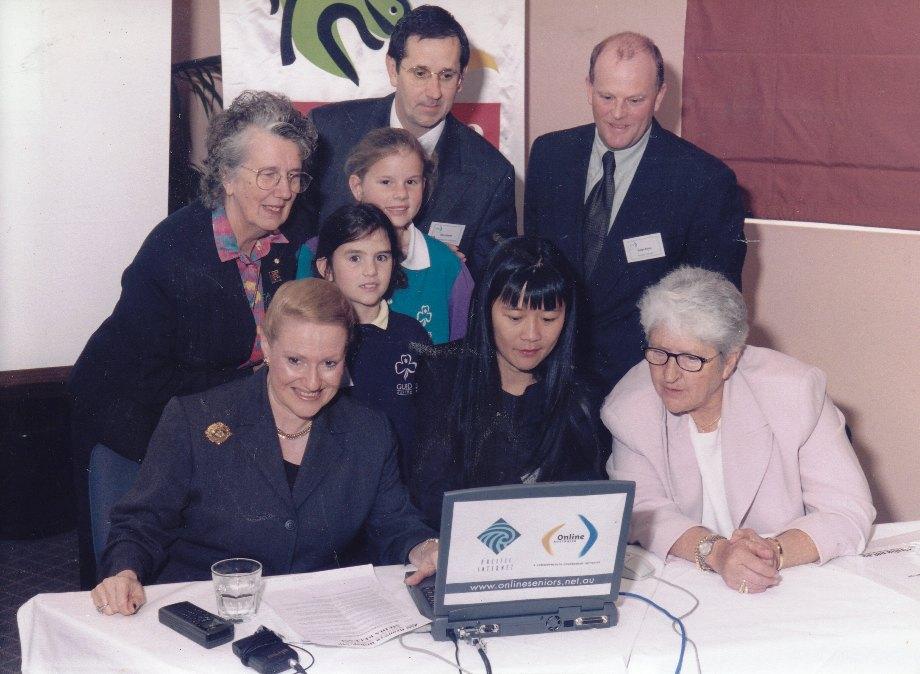
Above: 1999 Seniors Online Day
There is a vast amount of literature you have written on subjects ranging from craft to history, almost a work a year in some cases – how do you choose your subjects (or do they choose you) and how do you get them completed - what ‘working method’ do you employ?
I hadn’t thought of it before but I do think that what I write does sort of select me. The written word often completes or compliment whatever I am doing.
Apart from books I write articles for the media, organisations I’m involved in and blogs. I use words to weave pictures.
The craft books I wrote for Kangaroo Press back in the 1980s are the only ones that I have received payment for or royalties. All others have been written for the love of the topic or for an organisation or a cause.
Probably the biggest project was The Story of Bob Waterer and his family 1803 – 2010. The publisher was the Aboriginal Support Group-Manly Warringah Pittwater and originally it had been planned that an Aboriginal writer would undertake the book but no-one had the time to spare for such a voluntary project. I undertook to write and research the book while my dear friend Pat Frater agreed to be editor and also to help with the research particularly to build the family tree that went with the book. It was an enormous task as we were determined that only information that we could be proved would be used. Not an easy task when early Aboriginal history is mostly oral. We also had an Aboriginal consultant go through the book to make sure that it had been written in an appropriate and sensitive manner. To complete it and have it launched by the former Governor of New South Wales, Dame Marie Bashir, AC, CVO at an event hosted by Warringah Council was one of the memorable occasions in my life.
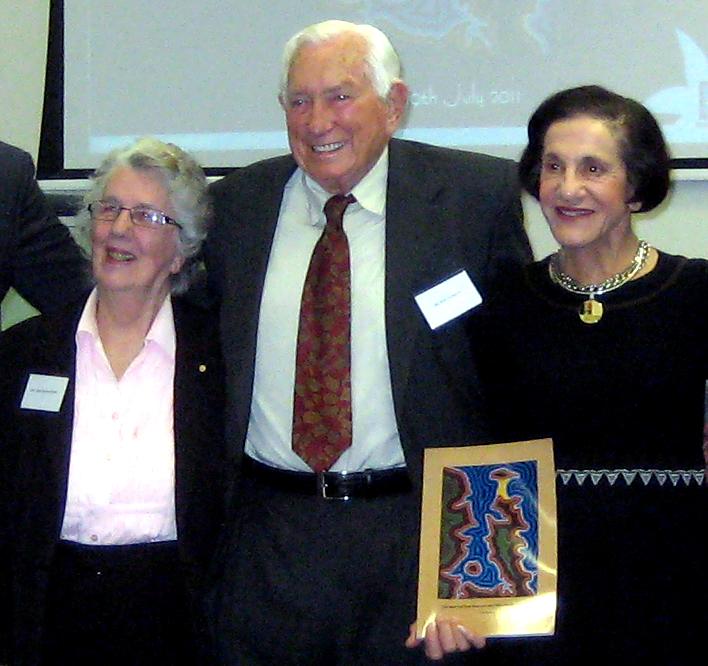
Bob Waterer and Nan Bosler with Dame Marie Bashir, AC, CVO
When ASCCA decided to organise a forum, Meet your Ancestors, for Seniors Week 2015 together with Joan Craymer and Mark Young from ASCCA I wrote a book to help those infected by the family history bug to begin researching their family story. That book is presently available for purchase via the ASCCA website, www.ascca.org.au
I have been researching my own family story for some 40 years and have at last begun to write a book, Convicts and Immigrants – to weave a nation. I planned to do a lot of writing during January when there weren’t many meetings but the last couple of years, for some reason, an almost free January didn’t end up in my diary. The book brings together the strands of my family as I explore how each of my ancestors arrived in the new colony and why. Of course I begin with my first fleeter, Frederick Meredith. Last year I went with my two daughters and two grand daughters to walk where our ancestors walked in Fiji and came home with the information I needed to finish the book. Just the index needs to be done but then it will be the search for a publisher.
Why aren’t you exhausted?; you’re a great –grandmother, write, work in a voluntary capacity still, attend overseas conferences representing Seniors, the BRAID conference in Ireland, the 2013 Korean gerontological – how do you maintain a healthy outlook and all the energy required?
At times I am exhausted but there are always things that need to be done, some exciting opportunity to explore or something that needs to be said. I have had some serious health issues to deal with but somehow motivation seems to see me through.
It has been wonderful to see what is being done in different countries as they address the issue of an ageing population and satisfying to see that we are often leading in some aspects. I have been able to attend conferences and seminars on topics ranging from technology, gerontology, family history, positive ageing and so on in Dublin and Dundalk in Ireland, Seoul and Busan in South Korea, Montevideo in Uruguay, Auckland in New Zealand, Prague in the Czech Republic, Singapore and every state of Australia. I am to be a speaker at the International intergenerational conference in Hawaii later this year.
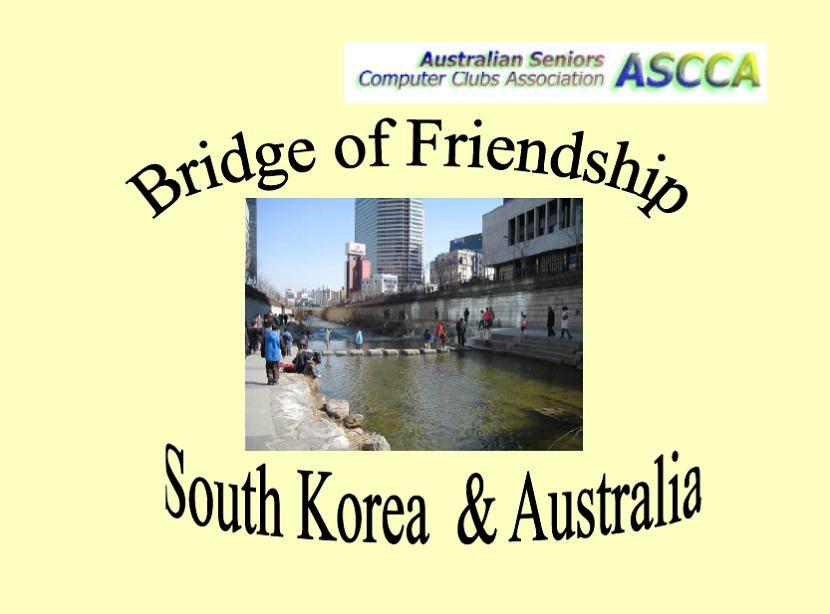
The Bridge of Friendship was something Nan organised after attending the conference at Yangsee University: "There was a display of photographs in the foyer of the University specially organised for the conference and I arranged for the photographers to exchange photographs with ASCCA members and use the photographs as a Bridge of Friendship."
See: ASCCA president Nan Bosler’s participation in the 2013 Korean Gerontological Events
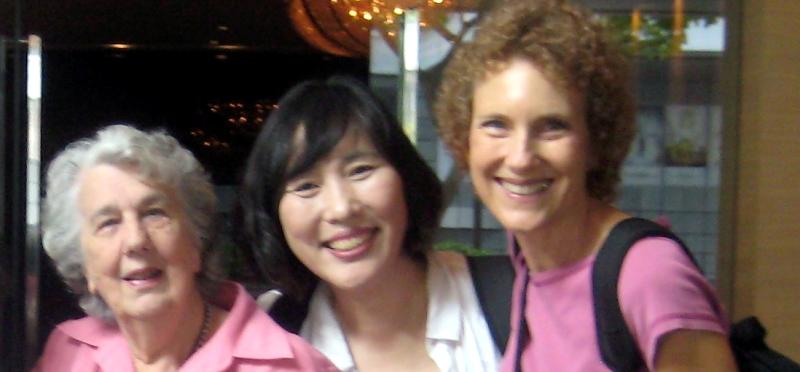
Nan with Dr. Dong Hee Han, Director, Research Institute of Science for the Better Living of the Elderly, Director, Busan Health Family Support Center Busan, Korea and Kathryn L. Braun, DrPH, Professor of Public Health and Social Work, University of Hawaii, Director, Office of Public Health Studies and President, Active Aging Consortium Asia Pacific
I have been involved with or started many organisations and without exception success has only been achieved by the joint efforts of many. Mostly I have been no more than a catalyst to start the ball rolling. Like most people I have traversed many high points and deep valleys during my life but somehow my family and the community I am so committed to has always provided the strength and encouragement to motivate me. Learning is a life-long experience and each day there is something new to think about.
What are the best things in your life right now?
Family, friends and my Community. And, how could I leave out my internet connection. The Internet is too good to miss.
What else do you hope to achieve?
I don’t know. Lots of ideas swirl around in my mind but I think life likes to take us places and give us options and we have to be ready to reach out and grasp the opportunities that seem appropriate.
What are your favourite places on the Northern Beaches and why?
There are many wonderful, meaningful and beautiful places along the northern beaches but my favourite place has to be my garden.
Let me share my garden with you.
There is a storage shed in the back corner of the yard but if I close my eyes I can see a cubby house and two excited little girls having yet another dinner party with food created by the seeds, buds and flowers of the plants and shrubs growing around the garden. I can still hear their giggles – I can’t believe that they are now both grandmothers!
Part of the wonderful tree canopy that shades much of the back yard is a tall and quite massive liquid amber tree. My son used to climb that tree to see the surf meet the beach and work out where the best sets were to go surfing. I would often drive him down to the beach because I was worried about him riding his bike down the steep hill with a surfboard tucked under his arm. I wanted to make sure that he was safe as he surfed so I would wait parked at the top of the sloping car park at Long Reef to watch. I did that for some months until the day he tapped me on the shoulder as I was still – I thought – watching him. Oh dear, I then had to admit that all the boys looked very much the same; black wet suits, blond hair and all exuberantly determined to catch the best waves. Being realistic; what could I do to help if he did get into strife! Apron strings neatly cut!
There is an azalea bush still flowering each spring. It is called Anniversary and we planted it to mark our 25th wedding anniversary. It grows near a camellia called String of Pearls which was my husband’s gift to me on our 30th anniversary – our pearl anniversary.
As the years continued to bring new joys, new challenges and new opportunities our garden flourished. A fairy garden was added with surprises always waiting for visits from grandchildren. I had begun when they were quite small to add packets of seeds to their Christmas stockings and what fun when they decided to see who could grow taller sunflowers than Nanna and Pardie.
Sadly Bill (Pardie) became quite ill and was no longer able to work and potter in the garden so I began to plant lots of pots of different colours and textures so that the areas that could be reached by his wheelchair were always a mass of colour. We particularly loved the spring bulbs. Our 50th anniversary was marked with the whole garden a mass of golden flowers of every size and shape.
Golden Wedding Anniversary in 2005: We had spent part of our honeymoon in Katoomba – we didn’t even imagine staying at the Carrington. But our children arranged the Carrington Suite for us and other rooms for ourselves and we spent a weekend in Katoomba, at the Carrington, to mark our 50th. Bill asked for just one thing – that we could go on the skyway. In a wheelchair, would it be possible?; it was possible and we made the trip.
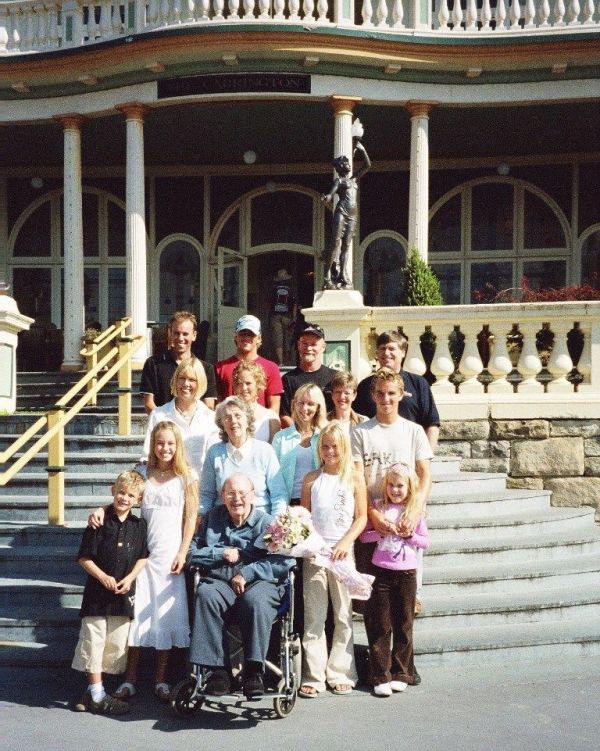
He is no longer with me but still I am creating lots of pot plants. To-day I have been sitting in my garden, the garden we created together all those years ago, gazing with fond thoughts at my garden of memories. The liquid amber towers above my head, the String of Pearls camellia is a mass of buds and there are even a few blossoms on the pink azalea. It gives me great peace.
I wish everyone had a garden of memories.
What is you ‘motto for life’ or a favourite phrase you try to live by?
That is hard to answer but I think it has to be the promise I made as a Girl Guide in 1946 which has stayed with me all my life – a promise to God, Queen, Country and to help others.
Nan Bosler OAM - Published works
Christmas Decorations in Australia by Nan Bosler - Published: 31 Dec 1983
Macrame Australian Animals & Flowers by Nan Bosler - Published: 31 Dec 1983
Australian patchwork & applique by Nan Bosler (1985)
Narrabeen: Memories of Narrabeen and Its Public School by Nan Bosler 1989
Easter by Nan Bosler 1988 - Illustrated edition
Fascinating History of Pittwater, Nan Bosler, Vols.1-4. 1997 - 2000.
Cubby House Toy Library: A History 1979-2001 by Nan Bosler- published 15 April 2001
Seniors' Telecommunication Issues by Nan Bosler Published: 01 Aug 2006
People and Places – Tracing Your Family History by Nan Bosler - Published: 01 Apr 2008
Introduction to Computers and the Internet authors, Nan Bosler & Diane Brentnal - - Australian Seniors Computer Club Association, 2009
Story of Bob Waterer and His Family 1803-2010 by Nan Bolser - 2011
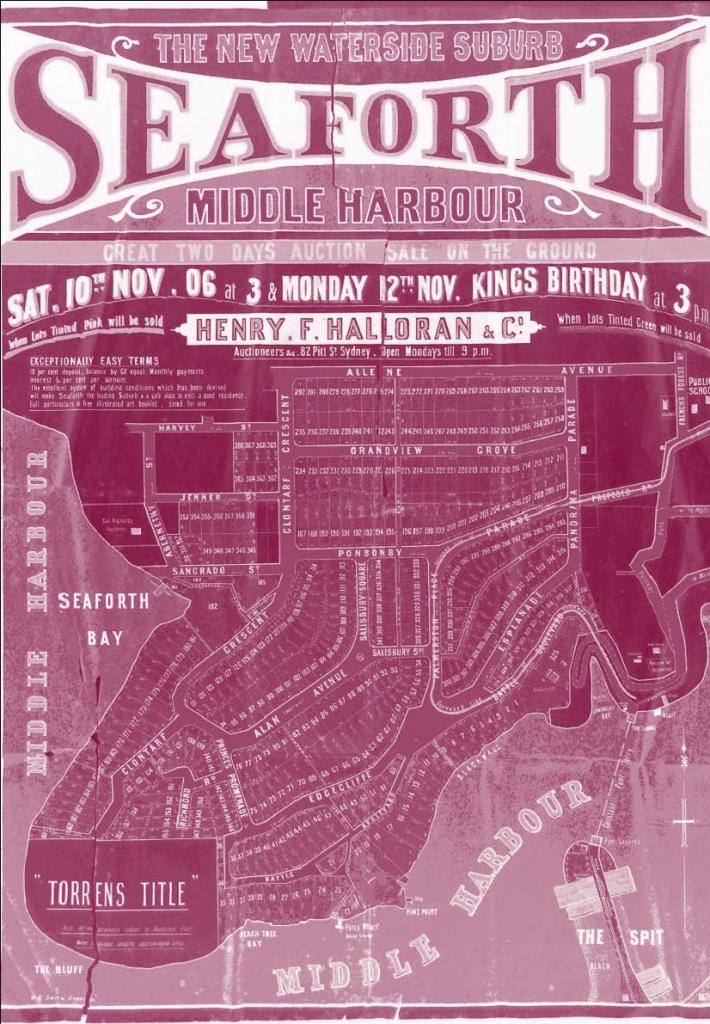
Above: H. F. Halloran & Co., 1906 C
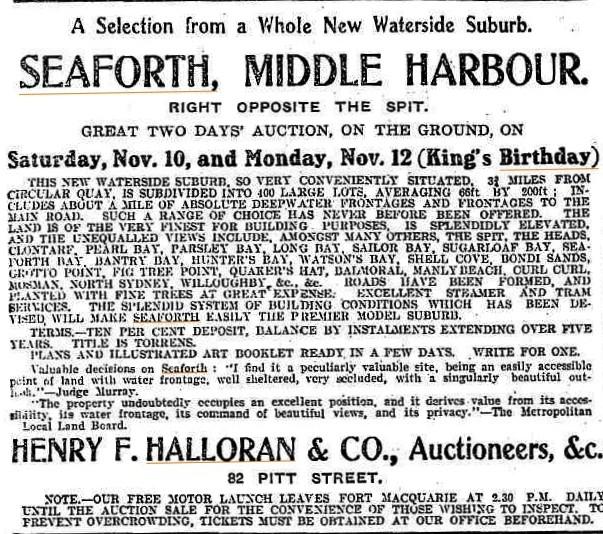
Above: Advertising. (1906, October 14). Sunday Times (Sydney, NSW : 1895 - 1930), p. 3. Retrieved from http://nla.gov.au/nla.news-article126567757
SALES BROCHURE: Seaforth, Middle Harbour, where fortunes can be made - Sydney : H. F. Halloran & Co., 1906 - PDF - 9.26 MB - Contains 30 pages: illustrations, photos, maps, ports - available online only - courtesy National Library of Australia at:www.nla.gov.au/apps/doview/nla.aus-vn6091-p.pdf
Tribudi W. Rahardjo, Professor, University Indonesia; Donghee Han, Secretary General, The Korean Gerontological Society; Nan Bosler in Busan.
Copyright Nan Bosler OAM, 2015.